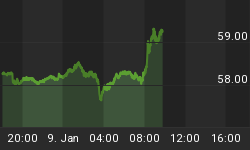Friday Labor Report To Set Weekly Tone

As of 2:30 p.m. EST Thursday, the S&P's weekly scorecard still reflected a loss of 11 points, meaning the outcome for the week will most likely be determined by the market's reaction to the always-obsessed-about monthly labor report. From CNN/Money:
Snowstorms, big annual revisions and the end of benefits for the long-term unemployed could give a distorted picture of the job market when January's labor report comes out Friday. Economists surveyed by CNNMoney are predicting 178,000 jobs were created last month. That would be a big improvement from December's shockingly low 74,000 jobs. Meanwhile, they predict the unemployment rate will remain at 6.7%. But wild cards like bad weather, yearly revisions and the end of federal jobless benefits, have economists on edge about their predictions.
Can Investors Participate During Market Advances?
When markets peak, it is logical to assume that investor demand for stocks begins to drop relative to (a) more conservative assets, such as bonds, or (b) risk-off assets, such as inverse stock ETFs (aka shorts). The charts below show how monitoring the demand for longs (SPY) vs. shorts (SH) can assist us with managing risk while attempting to profit from a rising stock market. This video clip describes how the ratio of longs vs. shorts below helped identify the favorable risk-reward environment that existed in 2006 as the S&P 500 gained 17% between point A1 and B1. The short explanation is when the demand for longs is greater than the demand for shorts, it indicates bullish economic conviction is greater than bearish economic conviction. During periods of bullish economic confidence, the ratio below rises, which it did in 2006 when the S&P 500 tacked on 17%.

How Does The Same Chart Look In 2014?
Even with Thursday's rally in stocks factored in, the present day look of the long vs. short ratio aligns with "risk-off", telling us that the bulls still have some work to do. The most important thing on a weekly chart is the "read" at 4:00 p.m. EST Friday, which means the jury has not returned a verdict yet.

How Did The 2014 Ratio Above Look In 2008?
This video clip describes how the ratio of longs vs. shorts below helped identify the unfavorable risk-reward environment that existed in 2008 as the S&P 500 experienced a 12% loss in June, and another 38% drop in Q4. Unlike 2006, economic conviction in 2008 was clearly lagging economic fear during the periods where the S&P 500 dropped (the ratio was also in a bearish downtrend).

Shift Could Help Stock Bulls
It has, for the most part, been a rough three weeks for the economic and stock market bulls. A ray of hope is welcome from the monetary policy front. From The Wall Street Journal:
"One development in financial markets that has received too little attention lately is a shift in market expectations about when the Federal Reserve will start raising interest rates. This is an issue we've harped on a bit lately (see Tuesday's take) and will return to today. Traders are pushing out their expectations for when the Fed will start raising short-term interest rates."
How About The 2010 Flash Crash?
The 2007-2008 peaking process in stocks took several months. Did the observable evidence provide warning signals before a much faster bearish event, such as the 2010 flash crash? The text below from The Economist serves as a refresher course on the 2010 plunge in equities:
On Friday October 1st, America's Securities and Exchange Commission and its Commodity Futures Trading Commission issued a joint report on the "flash crash" of May 6th. That afternoon, American share and futures indices went into a seemingly inexplicable tailspin, falling 10% in a matter of minutes, with some blue-chip shares briefly trading at a penny, only to recover most of the lost ground before the end of the trading day. The short-lived plunge raised awkward questions about whether trading rules had failed to keep up with markets that now handle orders in milliseconds.
The weekly chart below shows the performance of the S&P 500 (SPY) relative to bonds (AGG). When the ratio falls, it reflects weak demand for stocks relative to the demand for bonds. Common sense aligns with demand for conservative bonds increasing as investors begin to question the economy, earnings, or the stability of the financial system. Three trendlines were violated in a bearish manner on the chart below before the flash crash, which showed demand for bonds was increasing relative to stocks. The lower portion of the chart shows the S&P 500 also violated a trendline 10 days before the flash crash, which told us economic confidence was losing ground to economic fear.

How Does The Stock vs. Bond Chart Look In 2014?
Like the long vs. short ratio, the chart below tells us to maintain a healthy dose of skepticism before rushing to redeploy cash raised over the last four weeks. The ratio has been falling in recent weeks, indicating the demand for growth-oriented stocks is waning relative to defensive bonds. The economic and stock market bulls want the chart below to turn back up.

Investment Implications - Risk-On vs. Risk-Off 2014
In October, we listed flexibility as one of the keys to investment success. When financial markets rise with an unbalanced skew toward speculation relative to economic fundamentals, stocks can drop faster than they would in a more healthy and balanced environment.

As long as the observable evidence shows a mixed bias with no clear winner in terms of economic confidence relative to economic fear, we will continue to hold a mixed allocation of U.S. stocks (SPY), technology (QQQ), bonds (TLT), and a healthy dose of cash.
















